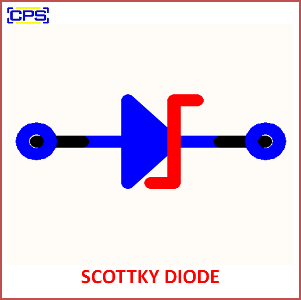A Schottky Diode is a type of semiconductor diode characterized by its low forward voltage drop and fast switching speed. It is formed by the junction of a metal and a semiconductor, creating a Schottky barrier instead of the traditional p-n junction found in standard diodes.

Key Features of a Schottky Diode
- Low Forward Voltage Drop:
- Typically ranges between 0.2V to 0.4V, which reduces power loss and heat generation.
- Fast Switching:
- Minimal charge storage enables rapid response in high-frequency applications.
- Construction:
- Made using a metal layer (e.g., aluminum, platinum) and an n-type semiconductor material.
Applications of Schottky Diodes:
- Rectification:
- Commonly used in power supply circuits for rectifying AC to DC due to low power loss.
- Clamping and Protection:
- Protects sensitive components from voltage spikes in circuits.
- RF Circuits:
- Used in radio frequency (RF) applications for signal detection and mixing.
- Power Management:
- Found in low-voltage power management systems to improve efficiency.
- Solar Panels:
- Prevents reverse current flow in photovoltaic systems.
Advantages:
- Low power loss due to low forward voltage.
- High efficiency in high-frequency and switching applications.
- Fast recovery time compared to standard diodes.
Disadvantages:
- Higher reverse leakage current than standard diodes.
- Lower reverse voltage rating, limiting use in high-voltage applications.
